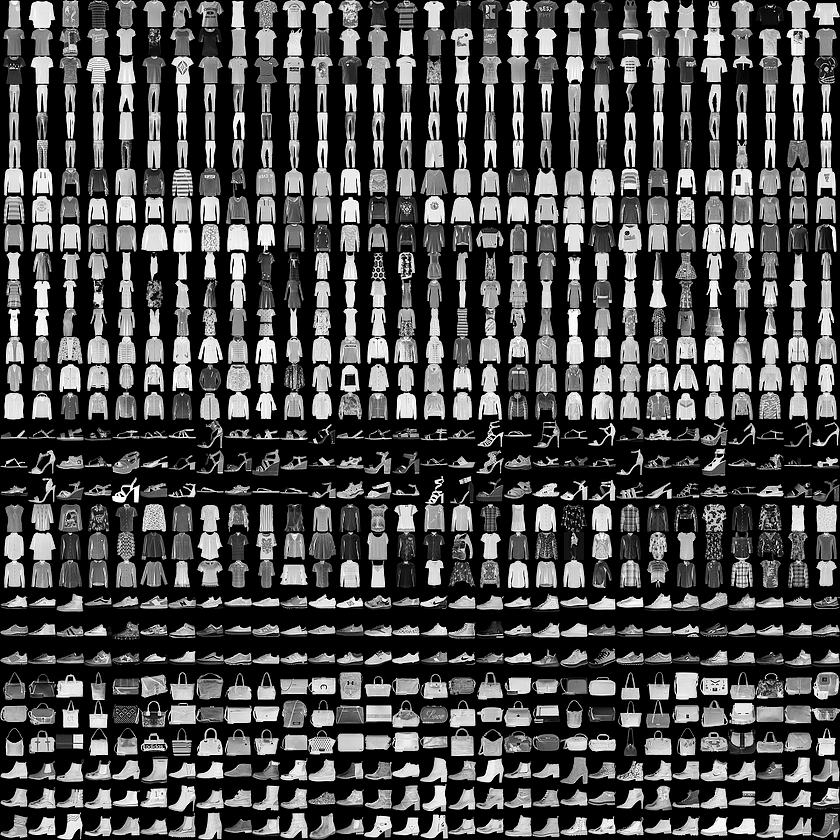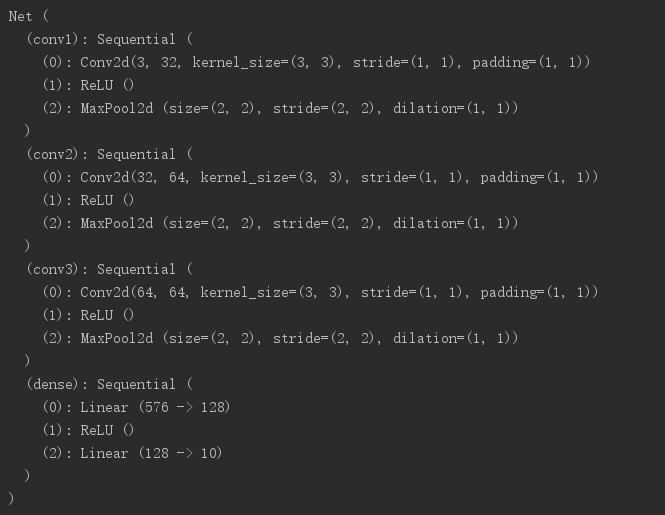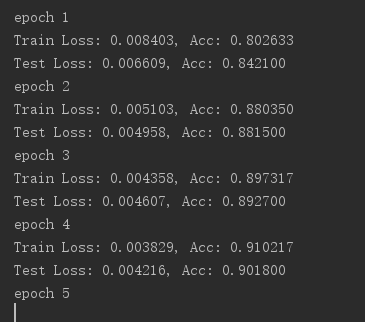pytorch: 準備、訓練和測試自己的圖片資料
阿新 • • 發佈:2018-12-29
大部分的pytorch入門教程,都是使用torchvision裡面的資料進行訓練和測試。如果我們是自己的圖片資料,又該怎麼做呢?
一、我的資料
我在學習的時候,使用的是fashion-mnist。這個資料比較小,我的電腦沒有GPU,還能吃得消。關於fashion-mnist資料,可以百度,也可以 點此 瞭解一下,資料就像這個樣子:


但是下載下來是一種二進位制檔案,並不是圖片,因此我先轉換成了圖片。
我先解壓gz檔案到e:/fashion_mnist/資料夾
然後執行程式碼:

import os from skimage import io import torchvision.datasets.mnist as mnist root="E:/fashion_mnist/" train_set = ( mnist.read_image_file(os.path.join(root, 'train-images-idx3-ubyte')), mnist.read_label_file(os.path.join(root, 'train-labels-idx1-ubyte')) ) test_set = ( mnist.read_image_file(os.path.join(root, 't10k-images-idx3-ubyte')), mnist.read_label_file(os.path.join(root,'t10k-labels-idx1-ubyte')) ) print("training set :",train_set[0].size()) print("test set :",test_set[0].size()) def convert_to_img(train=True): if(train): f=open(root+'train.txt','w') data_path=root+'/train/' if(not os.path.exists(data_path)): os.makedirs(data_path)for i, (img,label) in enumerate(zip(train_set[0],train_set[1])): img_path=data_path+str(i)+'.jpg' io.imsave(img_path,img.numpy()) f.write(img_path+' '+str(label)+'\n') f.close() else: f = open(root + 'test.txt', 'w') data_path = root + '/test/' if (not os.path.exists(data_path)): os.makedirs(data_path) for i, (img,label) in enumerate(zip(test_set[0],test_set[1])): img_path = data_path+ str(i) + '.jpg' io.imsave(img_path, img.numpy()) f.write(img_path + ' ' + str(label) + '\n') f.close() convert_to_img(True) convert_to_img(False)

這樣就會在e:/fashion_mnist/目錄下分別生成train和test資料夾,用於存放圖片。還在該目錄下生成了標籤檔案train.txt和test.txt.
二、進行CNN分類訓練和測試
先要將圖片讀取出來,準備成torch專用的dataset格式,再通過Dataloader進行分批次訓練。
程式碼如下:

import torch from torch.autograd import Variable from torchvision import transforms from torch.utils.data import Dataset, DataLoader from PIL import Image root="E:/fashion_mnist/" # -----------------ready the dataset-------------------------- def default_loader(path): return Image.open(path).convert('RGB') class MyDataset(Dataset): def __init__(self, txt, transform=None, target_transform=None, loader=default_loader): fh = open(txt, 'r') imgs = [] for line in fh: line = line.strip('\n') line = line.rstrip() words = line.split() imgs.append((words[0],int(words[1]))) self.imgs = imgs self.transform = transform self.target_transform = target_transform self.loader = loader def __getitem__(self, index): fn, label = self.imgs[index] img = self.loader(fn) if self.transform is not None: img = self.transform(img) return img,label def __len__(self): return len(self.imgs) train_data=MyDataset(txt=root+'train.txt', transform=transforms.ToTensor()) test_data=MyDataset(txt=root+'test.txt', transform=transforms.ToTensor()) train_loader = DataLoader(dataset=train_data, batch_size=64, shuffle=True) test_loader = DataLoader(dataset=test_data, batch_size=64) #-----------------create the Net and training------------------------ class Net(torch.nn.Module): def __init__(self): super(Net, self).__init__() self.conv1 = torch.nn.Sequential( torch.nn.Conv2d(3, 32, 3, 1, 1), torch.nn.ReLU(), torch.nn.MaxPool2d(2)) self.conv2 = torch.nn.Sequential( torch.nn.Conv2d(32, 64, 3, 1, 1), torch.nn.ReLU(), torch.nn.MaxPool2d(2) ) self.conv3 = torch.nn.Sequential( torch.nn.Conv2d(64, 64, 3, 1, 1), torch.nn.ReLU(), torch.nn.MaxPool2d(2) ) self.dense = torch.nn.Sequential( torch.nn.Linear(64 * 3 * 3, 128), torch.nn.ReLU(), torch.nn.Linear(128, 10) ) def forward(self, x): conv1_out = self.conv1(x) conv2_out = self.conv2(conv1_out) conv3_out = self.conv3(conv2_out) res = conv3_out.view(conv3_out.size(0), -1) out = self.dense(res) return out model = Net() print(model) optimizer = torch.optim.Adam(model.parameters()) loss_func = torch.nn.CrossEntropyLoss() for epoch in range(10): print('epoch {}'.format(epoch + 1)) # training----------------------------- train_loss = 0. train_acc = 0. for batch_x, batch_y in train_loader: batch_x, batch_y = Variable(batch_x), Variable(batch_y) out = model(batch_x) loss = loss_func(out, batch_y) train_loss += loss.data[0] pred = torch.max(out, 1)[1] train_correct = (pred == batch_y).sum() train_acc += train_correct.data[0] optimizer.zero_grad() loss.backward() optimizer.step() print('Train Loss: {:.6f}, Acc: {:.6f}'.format(train_loss / (len( train_data)), train_acc / (len(train_data)))) # evaluation-------------------------------- model.eval() eval_loss = 0. eval_acc = 0. for batch_x, batch_y in test_loader: batch_x, batch_y = Variable(batch_x, volatile=True), Variable(batch_y, volatile=True) out = model(batch_x) loss = loss_func(out, batch_y) eval_loss += loss.data[0] pred = torch.max(out, 1)[1] num_correct = (pred == batch_y).sum() eval_acc += num_correct.data[0] print('Test Loss: {:.6f}, Acc: {:.6f}'.format(eval_loss / (len( test_data)), eval_acc / (len(test_data))))

打印出來的網路模型:

訓練和測試結果:

原文連結
https://www.cnblogs.com/denny402/p/7520063.html
